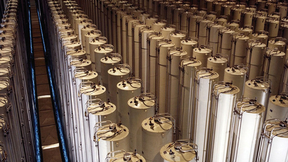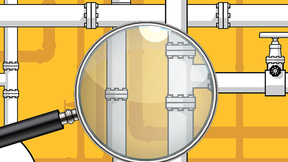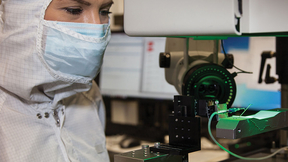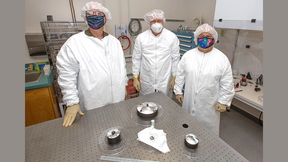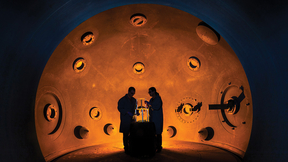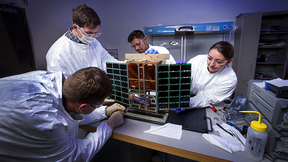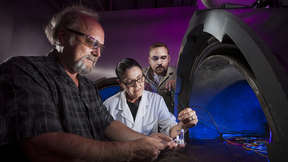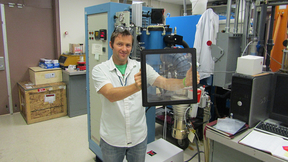Back
Lawrence Livermore scientists have performed a series of experiments through the National Ignition Facility’s (NIF’s) Discovery Science Program to replicate the extreme conditions within super-Earth cores and answered many questions posited by theoretical predictions and extrapolations from previously established relatively low pressure–temperature experimental data.
Lawrence Livermore researchers have worked for more than a decade to provide insights for a multifaceted emergency response, and in the process, they have advanced the science of sheltering and developed computer models to identify potentially life-saving strategies.
Of the four forces, the weak nuclear force is the least understood and most difficult to detect. A Lawrence Livermore team headed by physicist Nick Scielzo partnered with scientists from Argonne National Laboratory, Louisiana State University, and other universities to better characterize the weak force’s foundations. Thanks to significant advances in experimental design…
The Laboratory’s cutting-edge capabilities and expertise offer new tools to study ALS disease mechanisms and fuel hope for a cure.
Collaborative research and development focused on the extreme ultraviolet (EUV) end of the spectrum has resulted in state-of-the-art, multilayer reflective optics used for space exploration, manufacturing microchips, and more.
Having developed several transparent ceramics for radiation detection applications for the Department of Homeland Security and the Stockpile Stewardship Program, Lawrence Livermore recently leveraged its unique additive manufacturing resources and capabilities to develop transparent ceramics with properties not previously available for use as laser materials.
The Adaptive Computing Environment and Simulations (ACES) project will advance fissile materials production models and reduce risk of nuclear proliferation.
As with most mysteries, this one starts with a puzzling scene: a waterlogged field situated near Lawrence Livermore and Sandia national laboratories in Livermore, California. The property belongs to Wente Vineyards, a winery in the region, whose establishment predates the Laboratory by nearly 100 years. How the water got there and why was unclear, but the most likely…
Since the Industrial Revolution, atmospheric carbon dioxide (CO2) levels have continued to rise. While oceans, plants, and soils can sequester some of this CO2 naturally, they cannot capture and remove it all, causing the excess to make its way into the atmosphere. Long-term storage solutions are needed to address the surplus—a contributor to climate change—and help the…
The Department of Energy’s (DOE’s) Early Career Research Program (ECRP) aims to bolster the nation’s scientific workforce by providing support to exceptional researchers at U.S. academic institutions and DOE’s national laboratories during their early career years. Annually, ECRP provides research funding to full-time staff in their first 10 years post-doctorate.
A Livermore report outlines a strategy to reduce California’s carbon emissions to net zero by 2045.
Lawrence Livermore National Laboratory researchers aligned energetic materials knowledge and high-energy-density science expertise with experimental capabilities at the world’s most energetic laser, the National Ignition Facility.
Since its establishment, Lawrence Livermore has played a critical role in designing components for the Nuclear Security Enterprise (NSE), and more recently, in developing additively manufactured polymer parts to replace aging weapons stockpile parts.
In 2021, a small satellite bearing an imaging payload featuring two MonoTeles hitched a rideshare on a SpaceX Starlink launch at NASA’s Kennedy Space Center in Florida.
Since Lawrence Livermore’s inception in 1952, Laboratory researchers have been among the nation’s leaders in understanding, synthesizing, formulating, testing, assessing, and modeling the initiation systems and energetic materials (EM) that play an integral role in the U.S. nuclear deterrent, conventional munitions, and homeland security. The Laboratory’s Energetic…
Lawrence Livermore’s first involvement with CubeSats was developing optical imaging payloads for the Space-Based Telescopes for the Actionable Refinement of Ephemeris (STARE) project to monitor space debris. Since then, the Laboratory has continued to advance CubeSat technology and strengthen the institution’s space program.
At Lawrence Livermore, a key aspect of stockpile stewardship includes fine-tuning and experimentally observing HE detonation processes and developing computer models to predict the behavior of different HEs. Over the last several decades, HE detonation science has progressed toward higher resolution experimental and modeling capabilities that explore initiation processes,…
A Livermore team has developed a first-of-its kind transparent ceramic scintillator that significantly improves throughput for CT-based 3D imaging for manufacturing and other applications.
Energetic materials—explosives, propellants, and pyrotechnics—are substances that store and release large amounts of chemical energy. They are made by either physically mixing solid oxidizers and fuels to produce a composite energetic material, such as gunpowder, or by creating a molecule that contains both oxidizing and fuel components, such as TNT.
Representatives from government, industry, research institutions and academia in the United States and Brazil met at the Laboratory Tuesday and Wednesday to establish a "platform" for collaborative science and technology projects that have the potential to benefit public health and the environment, and stimulate economic development. The two-day forum, sponsored by the U.S…







